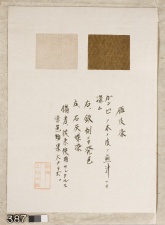Difference between revisions of "Gampi no ki - right (387 R)"
Jump to navigation
Jump to search
(username removed) |
(username removed) |
||
| (One intermediate revision by the same user not shown) | |||
| Line 5: | Line 5: | ||
| 387 | | 387 | ||
|- | |- | ||
| − | ! scope="row"| | + | ! scope="row"|Uemura number / title |
| − | | | + | | ; "Haze-some 25" |
|- | |- | ||
! scope="row"|Folder location | ! scope="row"|Folder location | ||
| Line 41: | Line 41: | ||
| - | | - | ||
|- | |- | ||
| − | ! scope="row"| | + | ! scope="row"|Uemura's notes |
| The plant had been used for dyeing; however the resultant colors seemed to be unsatisfactory. | | The plant had been used for dyeing; however the resultant colors seemed to be unsatisfactory. | ||
|- | |- | ||
| − | ! scope="row"| | + | ! scope="row"|Uemura's date |
| Kyoto | | Kyoto | ||
|} | |} | ||
| − | [[Category: | + | [[Category:Uemura dye archive]] |
Latest revision as of 06:21, 24 July 2013
| Museum number | 387 |
|---|---|
| Uemura number / title | ; "Haze-some 25" |
| Folder location | 5th shelf |
| Sample location | right (387 R) |
| Fiber type | silk |
| Color | dark brown (more black tone) |
| Dyestuff (Japanese common name) | ガンピの木 : Gampi no ki |
| Dyestuff (botanical name) | Diplomorpha sikokiana (Franch. Et Sav.) Honda |
| Plant part | bark / unspecified |
| Dyestuff extraction | boiled in water |
| Auxiliary agent in dye bath | - |
| Mordant | iron |
| Other auxiliary agent | - |
| Uemura's notes | The plant had been used for dyeing; however the resultant colors seemed to be unsatisfactory. |
| Uemura's date | Kyoto |
